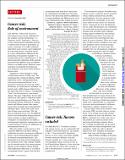| dc.contributor.author | Ashford, Nicholas A. | |
| dc.contributor.author | Bauman, Patricia | |
| dc.contributor.author | Brown, Halina | |
| dc.contributor.author | Clapp, Richard | |
| dc.contributor.author | Finkel, Adam | |
| dc.contributor.author | Gee, David | |
| dc.contributor.author | Hattis, Dale | |
| dc.contributor.author | Martuzzi, Marco | |
| dc.contributor.author | Sasco, Annie | |
| dc.contributor.author | Sass, Jennifer | |
| dc.date.accessioned | 2021-07-14T17:08:22Z | |
| dc.date.available | 2021-07-14T17:08:22Z | |
| dc.date.issued | 2015 | |
| dc.identifier.uri | https://hdl.handle.net/1721.1/131091 | |
| dc.description | Letter to the Editor | en_US |
| dc.description.abstract | IN THEIR REPORT “Variation in cancer risk among tissues can be explained by the number of stem cell divisions” (2 January, p. 78), C. Tomasetti and B. Vogelstein discuss an interesting correlation (0.804) between estimated lifetime stem cell division number in 31 tissue types and corresponding cancer incidence rates in the United States. However, their assertion that only 35% of cancer risk variation is due to environmental or genetic factors is problematic. | en_US |
| dc.language.iso | en_US | en_US |
| dc.publisher | Science | en_US |
| dc.rights | Attribution-NonCommercial-NoDerivs 3.0 United States | * |
| dc.rights.uri | http://creativecommons.org/licenses/by-nc-nd/3.0/us/ | * |
| dc.title | Cancer Risk: Role of Environment | en_US |
| dc.type | Other | en_US |
